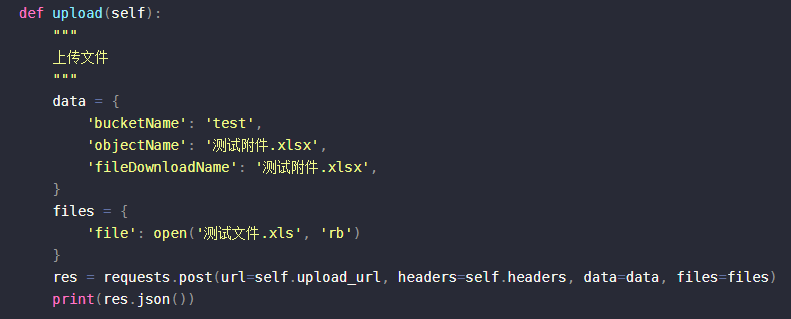
Python如何上传文件?
场景描述在工作中经常需要把一些文件上传到服务器,以方便使用和管理,如:将文件上传到腾讯云的对象存储(COS)。那么该如何使用Python实现文件上传呢?代码示例import requestsclass Upload:def __init__(self):"""基础配置"""# 请求头self.headers = {'User-Agent': 'Mozilla/5.0 (W
·
场景描述
在工作中经常需要把一些文件上传到服务器,以方便使用和管理,如:将文件上传到腾讯云的对象存储(COS)。那么该如何使用Python实现文件上传呢?
方案一
import requests
class Upload:
def __init__(self):
"""
基础配置
"""
# 请求头
self.headers = {
'User-Agent': 'Mozilla/5.0 (Windows NT 10.0; Win64; x64) AppleWebKit/537.36 (KHTML, like Gecko) Chrome/96.0.4664.45 Safari/537.36'
}
# 上传链接
self.upload_url = 'https://api.test.cn/upload' # POST方法
def upload(self):
"""
上传文件
"""
data = {
'bucketName': 'test',
'objectName': '测试附件.xlsx',
'fileDownloadName': '测试附件.xlsx',
}
files = {
'file': open('测试文件.xls', 'rb')
}
res = requests.post(url=self.upload_url, headers=self.headers, data=data, files=files)
print(res.json())
if __name__ == '__main__':
upload = Upload()
upload.upload()
方案二
import os
import sys
import pymysql
import requests
import you_get
class Upload:
def __init__(self):
"""
基础配置
"""
# 请求头
self.headers = {
'User-Agent': 'Mozilla/5.0 (Windows NT 10.0; Win64; x64) AppleWebKit/537.36 (KHTML, like Gecko) Chrome/99.0.4844.51 Safari/537.36'
}
# 上传链接
self.upload_url = 'https://api.test.cn/upload' # POST方法
def update_data(self):
"""
更新数据,补全数据库中视频对应的oss链接
"""
connection = pymysql.connect(
host='host',
user='user',
password='password',
database='db',
charset='utf8mb4',
cursorclass=pymysql.cursors.DictCursor
)
with connection:
with connection.cursor() as cursor:
# 获取所有数据
cursor.execute('select id, video_title, video_url, video_oss from video_bilibili;')
for item in cursor.fetchall():
if not item.get('video_oss'):
print('*' * 60)
# 下载视频
print(item.get('video_title'))
self.download(item.get('video_url'), item.get('video_title'))
# 上传视频
if video_oss := self.upload(item.get('video_title')):
# 编辑SQL语句
sql = f"update video_bilibili set video_oss='{video_oss}' where id={item.get('id')};"
# 执行SQL语句,更新数据
try:
cursor.execute(sql)
connection.commit()
except Exception as e:
print(e)
print(item)
def download(self, url, filename):
"""
下载视频
"""
sys.argv = ['you-get', '-O', filename, url]
you_get.main()
def upload(self, title):
"""
上传文件
"""
files = [
('files', (
f'{title}.mp4', # 文件名称
open(f'{title}.mp4', 'rb'), # 读取文件
'application/octet-stream'
))
]
# 上传文件
response = requests.post(url=self.upload_url, headers=self.headers, files=files)
if response.json().get('code') == 200:
video_oss = response.json().get('data')[0].get('urlPath')
# 删除已下载的数据
for file in os.listdir():
if os.path.splitext(file)[1] == '.mp4' or os.path.splitext(file)[1] == '.xml':
os.remove(file)
# 返回oss链接
return video_oss
if __name__ == '__main__':
upload = Upload()
# upload.upload('上传测试文件')
upload.update_data()
说明:该过程使用requests模拟了在Postman中使用form-data上传文件的过程。
流程:先使用you-get根据数据库中存储的第三方视频链接将视频下载下来,然后再使用upload方法将视频上传至oss,这时会获取到oss链接,最后将获取到的oss链接更新到对应的数据库中即可。
注意:具体操作根据实际情况而定,这里只提供思路。
参考链接
更多推荐
 已为社区贡献7条内容
已为社区贡献7条内容









所有评论(0)